Prediction of Ultra-High-Performance Concrete (UHPC) Properties Using Gene Expression Programming (GEP)
Abstract
:1. Introduction
2. Gene Expression Programming (GEP)
2.1. Overview of GEP ML Technique
2.2. Employed Methodology for GEP ML Technique
3. Dataset Description
3.1. UHPC Flowability
3.2. UHPC Compressive Strength
3.3. UHPC Flexural Strength
3.4. UHPC Porosity
4. Results and Analysis
4.1. GEP Modelling for UHPC Flowability (FA)
Development of Jupyter-Driven Graphical User Interface (GUI) for UHPC Flowability
- Cement content and cement compressive strength determine the binder’s capacity and the matrix’s strength, which are directly related to the viscosity and stability of the mix.
- Cement type and cement strength class can alter the rheology of the mixture, which impacts how easily the shotcrete flows.
- Additives like fly ash, slag, and silica fume can improve workability and reduce water demand, enhancing flowability without sacrificing cohesion.
- Nano-silica and limestone powder contribute to the filler effect and particle packing, optimizing the flow.
- Coarse aggregate content and sand content, along with Maximum aggregate size, are crucial for maintaining a balance between flowability and the prevention of segregation during application.
- Quartz powder acts as a micro-filler, improving the interface between aggregates and cement paste.
- The water content and superplasticizer content are key factors in achieving the desired consistency and workability for shotcrete application.
- Fiber additions, such as polystyrene fiber content, polystyrene fiber diameter, polystyrene fiber length, steel fiber content, steel fiber diameter, and steel fiber length, influence the fresh and hardened properties of UHPC, affecting its viscosity, and thus the flowability.
4.2. GEP Modelling for UHPC Compressive Strength (CS)
Establishment of Jupyter-Based Graphical User Interface (GUI) for UHPC Compressive Strength
- Cement content, cement compressive strength, cement type, and cement strength class establish the backbone of the UHPC matrix, providing the primary binding material that governs strength development.
- Fly ash, slag, and silica fume, as pozzolanic materials, contribute to the microstructural refinement of UHPC, leading to higher density, and thus enhanced compressive strength.
- Nano-silica promotes the pozzolanic reaction and fills voids at the nanoscale, contributing to increased strength.
- Limestone powder acts as a fine aggregate and can enhance the particle packing, thus improving the compressive strength.
- Sand content and coarse aggregate content, along with the maximum aggregate size, are optimized to facilitate dense packing and minimize voids, directly influencing strength.
- Quartz powder further refines the microstructure and can contribute to strength development due to its hard nature.
- Water content must be carefully balanced to provide workability without weakening the concrete matrix.
- The higher compressive strength of UHPC along with adequate workability may be achieved using superplasticizer instead of increasing water content, hence the content of superplasticizer is crucial.
- The dispersed reinforcement in UHPC is provided by incorporating steel and polystyrene fibers of different diameters and lengths. This dispersed reinforcement is aimed to increase the tensile strength of composite, ultimately adding in UHPC toughness. This enhanced toughness of UHPC is desirable for UHPC columns that are exposed to fluctuating loads.
- The achievement of maximum UHPC strength is also relatable to the curing time. The proper pozzolanic and hydration reactions are attained in case the incorporated cementitious materials receive proper curing.
4.3. GEP Modelling for UHPC Flexural Strength (FS)
Creation of Jupyter-Based Graphical User Interface (GUI) for UHPC Flexural Strength
- Cement-related parameters contribute to the initial matrix strength, which is fundamental to the beam’s ability to resist bending.
- Fly ash, slag, and silica fume enhance the microstructure and contribute to the high-density matrix of UHPC, which supports greater flexural strength.
- Nano-silica assists in optimizing the microstructure for superior mechanical properties, including flexural strength.
- Limestone powder serves as a micro-filler, promoting dense packing and contributing to the flexural rigidity of the beam.
- Sand content and coarse aggregate content, as well as maximum aggregate size, are critical for achieving a balance between workability and a compact matrix for improved flexural response.
- Also, the flexural properties of UHPC can also be benefitted by the incorporation of quartz powder, enhancing the stiffness of composite.
- The adequate consistency of UHPC mix is obtained by adjusting water content, but without disturbing the integrity of matrix.
- Similarly, instead of enhancing the water content, superplasticizers may be incorporated to achieve more workability, but without adding additional water. This may also contribute towards maximizing the flexural strength.
- The incorporation of dispersed fibers, i.e., steel and polystyrene, considerably contributes towards attainment of enhanced flexural strength due to the crack-arresting bridging effect provided by the dispersed fibers, ultimately enhancing the toughness of UHPC. These specifications are highly beneficial for the beam applications where both the static and dynamic loadings are to be resisted.
- It is also reported that the adequate completion of hydration process due to proper curing time considerably contributes towards development of the mechanical properties of cementitious composites. Hence, the UHPC flexural strength can also be enhanced by proper curing, which is highly beneficial for the beam applications.
4.4. GEP Modelling for UHPC Porosity (PR)
Rendering of Jupyter-Based Graphical User Interface (GUI) for UHPC Porosity
- Cement content and the associated parameters dictate the density and strength of the cement matrix, influencing the overall porosity.
- Pozzolanic materials such as fly ash, slag, and silica fume contribute to the pozzolanic reaction, which refines the pore structure and reduces porosity.
- Nano-silica reacts with calcium hydroxide to form additional calcium silicate hydrate (C-S-H), reducing the void spaces within the concrete.
- Limestone powder can enhance the packing density of the mix, further reducing porosity.
- Sand, coarse aggregate content, and maximum aggregate size are optimized for a tight gradation that minimizes voids, and thus porosity.
- Quartz powder, known for its hardness, also contributes to a more compact concrete structure when used as a fine filler.
- The water content in the mix is crucial since excessive water can lead to increased porosity upon evaporation.
- Superplasticizer aids in reducing water content without losing workability, thus maintaining a low porosity.
- The uniform distribution of steel and polystyrene fibers in the UHPC mix assist in crack arresting to resist the propagation of cracks in the respective matrix. This behavior can lead towards reduced porosity.
- Moreover, the proper completion of hydration process is attained through proper curing, which results in better microstructure and porosity.
5. Discussion
6. Conclusions
- The GEP method offers a simplified, equation-based representation of UHPC characteristics such as flowability, compressive strength, flexural strength, and porosity. It demonstrates a high level of accuracy, closely aligning with both modeled and experimental results, effectively accounting for both linear and nonlinear data.
- The GEP model provides the necessary equations for accurate prediction of UHPC characteristics using manual computations, making the evaluation process more straightforward and reliable.
- By incorporating a range of input factors, the GEP machine learning model achieved high accuracy in predicting UHPC properties, with R2-values of 0.94, 0.95, 0.93, and 0.94 for flowability, compressive strength, flexural strength, and porosity, respectively.
- The value of R2 for GEP in predicting flowability, compressive strength, flexural strength, and porosity of UHPC is higher than that of other models (ANN and SVM etc.) in previous studies.
- A GUI was developed to visualize and predict UHPC properties, including flowability, compressive and flexural strengths, and porosity. The GUI enhances the user experience for researchers by providing an intuitive, efficient, and visually appealing platform, thereby improving overall productivity.
Supplementary Materials
Author Contributions
Funding
Data Availability Statement
Conflicts of Interest
References
- Shi, C.; Wu, Z.; Xiao, J.; Wang, D.; Huang, Z.; Fang, Z. A review on ultra high performance concrete: Part I. Raw materials and mixture design. Constr. Build. Mater. 2015, 101, 741–751. [Google Scholar] [CrossRef]
- Wu, Z.; Shi, C.; He, W.; Wang, D. Uniaxial compression behavior of ultra-high performance concrete with hybrid steel fiber. J. Mater. Civ. Eng. 2016, 28, 06016017. [Google Scholar] [CrossRef]
- Khan, M.; Kai, M.; Ahmad, M.R.; Lao, J.; Dai, J.-G. Fire Performance of Fiber-reinforced Ultra-High-Performance Concrete: A state-of-the-art review. J. Asian Concr. Fed. 2023, 9, 65–102. [Google Scholar] [CrossRef]
- Park, S.H.; Kim, D.J.; Ryu, G.S.; Koh, K.T. Tensile behavior of ultra high performance hybrid fiber reinforced concrete. Cem. Concr. Compos. 2012, 34, 172–184. [Google Scholar] [CrossRef]
- Habel, K.; Viviani, M.; Denarié, E.; Brühwiler, E. Development of the mechanical properties of an ultra-high performance fiber reinforced concrete (UHPFRC). Cem. Concr. Res. 2006, 36, 1362–1370. [Google Scholar] [CrossRef]
- Schmidt, M.; Fehling, E. Ultra-high-performance concrete: Research, development and application in Europe. ACI Spec. Publ. 2005, 228, 51–78. [Google Scholar]
- Wang, D.; Shi, C.; Wu, Z.; Xiao, J.; Huang, Z.; Fang, Z. A review on ultra high performance concrete: Part II. Hydration, microstructure and properties. Constr. Build. Mater. 2015, 96, 368–377. [Google Scholar] [CrossRef]
- Ali, B.; Farooq, M.A.; El Ouni, M.H.; Azab, M.; Elhag, A.B. The combined effect of coir and superplasticizer on the fresh, mechanical, and long-term durability properties of recycled aggregate concrete. J. Build. Eng. 2022, 59, 105009. [Google Scholar] [CrossRef]
- Zhang, C.; Ali, A. The advancement of seismic isolation and energy dissipation mechanisms based on friction. Soil Dyn. Earthq. Eng. 2021, 146, 106746. [Google Scholar] [CrossRef]
- Essam, A.; Mostafa, S.A.; Khan, M.; Tahwia, A.M. Modified particle packing approach for optimizing waste marble powder as a cement substitute in high-performance concrete. Constr. Build. Mater. 2023, 409, 133845. [Google Scholar] [CrossRef]
- Zhou, M.; Lu, W.; Song, J.; Lee, G.C. Application of ultra-high performance concrete in bridge engineering. Constr. Build. Mater. 2018, 186, 1256–1267. [Google Scholar] [CrossRef]
- Yoo, D.-Y.; Banthia, N. Mechanical properties of ultra-high-performance fiber-reinforced concrete: A review. Cem. Concr. Compos. 2016, 73, 267–280. [Google Scholar] [CrossRef]
- Yu, R.; Spiesz, P.; Brouwers, H. Mix design and properties assessment of ultra-high performance fibre reinforced concrete (UHPFRC). Cem. Concr. Res. 2014, 56, 29–39. [Google Scholar] [CrossRef]
- Khan, M.; Lao, J.; Ahmad, M.R.; Kai, M.-F.; Dai, J.-G. The role of calcium aluminate cement in developing an efficient ultra-high performance concrete resistant to explosive spalling under high temperatures. Constr. Build. Mater. 2023, 384, 131469. [Google Scholar] [CrossRef]
- Lao, J.-C.; Xu, L.-Y.; Huang, B.-T.; Zhu, J.-X.; Khan, M.; Dai, J.-G. Utilization of sodium carbonate activator in strain-hardening ultra-high-performance geopolymer concrete (SH-UHPGC). Front. Mater. 2023, 10, 1142237. [Google Scholar] [CrossRef]
- Chen, Y.X.; Li, S.; Mezari, B.; Hensen, E.J.; Yu, R.; Schollbach, K. Effect of highly dispersed colloidal olivine nano-silica on early age properties of ultra-high performance concrete. Cem. Concr. Compos. 2022, 131, 104564. [Google Scholar] [CrossRef]
- Liu, J.; Shi, C.; Wu, Z. Hardening, microstructure, and shrinkage development of UHPC: A review. J. Asian Concr. Fed. 2019, 5, 1–19. [Google Scholar] [CrossRef]
- Kang, S.-T.; Kim, J.H.; Lee, B.Y. Effects of water reducing admixture on rheological properties, fiber distribution, and mechanical behavior of UHPFRC. Appl. Sci. 2018, 9, 29. [Google Scholar] [CrossRef]
- Le Hoang, A.; Fehling, E. Influence of steel fiber content and aspect ratio on the uniaxial tensile and compressive behavior of ultra high performance concrete. Constr. Build. Mater. 2017, 153, 790–806. [Google Scholar] [CrossRef]
- Larsen, I.L.; Thorstensen, R.T. The influence of steel fibres on compressive and tensile strength of ultra high performance concrete: A review. Constr. Build. Mater. 2020, 256, 119459. [Google Scholar] [CrossRef]
- Jiang, X.; Zhang, Y.; Xiao, R.; Polaczyk, P.; Zhang, M.; Hu, W. A comparative study on geopolymers synthesized by different classes of fly ash after exposure to elevated temperatures. J. Clean. Prod. 2020, 270, 122500. [Google Scholar] [CrossRef]
- Raza, S.S.; Amir, M.T.; Azab, M.; Ali, B.; Abdallah, M.; El Ouni, M.H.; Elhag, A.B. Effect of micro-silica on the physical, tensile, and load-deflection characteristics of micro fiber-reinforced high-performance concrete (HPC). Case Stud. Constr. Mater. 2022, 17, e01380. [Google Scholar] [CrossRef]
- Zhang, W.; Huang, Y. Three-dimensional numerical investigation of mixed-mode debonding of FRP-concrete interface using a cohesive zone model. Constr. Build. Mater. 2022, 350, 128818. [Google Scholar] [CrossRef]
- Khan, M.; Lao, J.; Ahmad, M.R.; Dai, J.-G. Influence of high temperatures on the mechanical and microstructural properties of hybrid steel-basalt fibers based ultra-high-performance concrete (UHPC). Constr. Build. Mater. 2024, 411, 134387. [Google Scholar] [CrossRef]
- Huang, Y.; Zhang, W.; Liu, X. Assessment of Diagonal Macrocrack-Induced Debonding Mechanisms in FRP-Strengthened RC Beams. J. Compos. Constr. 2022, 26, 04022056. [Google Scholar] [CrossRef]
- Kumar, B.N.; Kumar, P.P. Prediction on Flexural strength of High Strength Hybrid Fiber Self Compacting Concrete by using Artificial Intelligence. J. Artif. Intell. 2022, 4, 1–16. [Google Scholar] [CrossRef]
- Nehdi, M.; El Chabib, H.; El Naggar, M.H. Predicting performance of self-compacting concrete mixtures using artificial neural networks. Mater. J. 2001, 98, 394–401. [Google Scholar]
- Nguyen, T.T.; Duy, H.P.; Thanh, T.P.; Vu, H.H. Compressive Strength Evaluation of Fiber-Reinforced High-Strength Self-Compacting Concrete with Artificial Intelligence. Adv. Civ. Eng. 2020, 2020, 3012139. [Google Scholar] [CrossRef]
- Asri, Y.E.; Aicha, M.B.; Zaher, M.; Alaoui, A.H. Prediction of compressive strength of self-compacting concrete using four machine learning technics. Mater. Today Proc. 2022, 57, 859–866. [Google Scholar] [CrossRef]
- de-Prado-Gil, J.; Palencia, C.; Silva-Monteiro, N.; Martínez-García, R. To predict the compressive strength of self compacting concrete with recycled aggregates utilizing ensemble machine learning models. Case Stud. Constr. Mater. 2022, 16, e01046. [Google Scholar] [CrossRef]
- Balf, F.R.; Kordkheili, H.M.; Kordkheili, A.M. A New method for predicting the ingredients of self-compacting concrete (SCC) including fly ash (FA) using data envelopment analysis (DEA). Arab. J. Sci. Eng. 2021, 46, 4439–4460. [Google Scholar] [CrossRef]
- Kovačević, M.; Lozančić, S.; Nyarko, E.K.; Hadzima-Nyarko, M. Modeling of compressive strength of self-compacting rubberized concrete using machine learning. Materials 2021, 14, 4346. [Google Scholar] [CrossRef] [PubMed]
- Zhang, Z.; Liang, G.; Niu, Q.; Wang, F.; Chen, J.; Zhao, B.; Ke, L. A Wiener degradation process with drift-based approach of determining target reliability index of concrete structures. Qual. Reliab. Eng. Int. 2022, 38, 3710–3725. [Google Scholar] [CrossRef]
- Marani, A.; Jamali, A.; Nehdi, M.L. Predicting ultra-high-performance concrete compressive strength using tabular generative adversarial networks. Materials 2020, 13, 4757. [Google Scholar] [CrossRef]
- Lu, J.; Yu, Z.; Zhu, Y.; Huang, S.; Luo, Q.; Zhang, S. Effect of lithium-slag in the performance of slag cement mortar based on least-squares support vector machine prediction. Materials 2019, 12, 1652. [Google Scholar] [CrossRef] [PubMed]
- Solhmirzaei, R.; Salehi, H.; Kodur, V.; Naser, M. Machine learning framework for predicting failure mode and shear capacity of ultra high performance concrete beams. Eng. Struct. 2020, 224, 111221. [Google Scholar] [CrossRef]
- Ferreira, C. Gene Expression Programming, Mathematical Modeling by an Artificial Intelligence, 2nd ed.; Springer: Berlin/Heidelberg, Germany, 2006; pp. XX, 480. [Google Scholar]
- Gandomi, A.; Yun, G.; Alavi, A. An evolutionary approach for modeling of shear strength of RC deep beams. Mater. Struct. 2013, 46, 2109–2119. [Google Scholar] [CrossRef]
- Gandomi, A.H.; Babanajad, S.K.; Alavi, A.H.; Farnam, Y. Novel Approach to Strength Modeling of Concrete under Triaxial Compression. J. Mater. Civ. Eng. 2012, 24, 1132–1143. [Google Scholar] [CrossRef]
- Khan, M.; Lao, J.; Dai, J.-G. Comparative study of advanced computational techniques for estimating the compressive strength of UHPC. J. Asian Concr. Fed. 2022, 8, 51–68. [Google Scholar] [CrossRef]
- Wang, Q.; Hussain, A.; Farooqi, M.U.; Deifalla, A.F. Artificial intelligence-based estimation of ultra-high-strength concrete’s flexural property. Case Stud. Constr. Mater. 2022, 17, e01243. [Google Scholar] [CrossRef]
- Chaabene, W.B.; Flah, M.; Nehdi, M.L. Machine learning prediction of mechanical properties of concrete: Critical review. Constr. Build. Mater. 2020, 260, 119889. [Google Scholar] [CrossRef]
- Suleiman, A.R.; Nehdi, M.L. Modeling self-healing of concrete using hybrid genetic algorithm–artificial neural network. Materials 2017, 10, 135. [Google Scholar] [CrossRef] [PubMed]
- Marani, A.; Nehdi, M.L. Machine learning prediction of compressive strength for phase change materials integrated cementitious composites. Constr. Build. Mater. 2020, 265, 120286. [Google Scholar] [CrossRef]
- Castelli, M.; Vanneschi, L.; Silva, S. Prediction of high performance concrete strength using genetic programming with geometric semantic genetic operators. Expert Syst. Appl. 2013, 40, 6856–6862. [Google Scholar] [CrossRef]
- Han, Q.; Gui, C.; Xu, J.; Lacidogna, G. A generalized method to predict the compressive strength of high-performance concrete by improved random forest algorithm. Constr. Build. Mater. 2019, 226, 734–742. [Google Scholar] [CrossRef]
- Al-Shamiri, A.K.; Yuan, T.-F.; Kim, J.H. Non-tuned machine learning approach for predicting the compressive strength of high-performance concrete. Materials 2020, 13, 1023. [Google Scholar] [CrossRef]
- Dingqiang, F.; Rui, Y.; Zhonghe, S.; Chunfeng, W.; Jinnan, W.; Qiqi, S. A novel approach for developing a green Ultra-High Performance Concrete (UHPC) with advanced particles packing meso-structure. Constr. Build. Mater. 2020, 265, 120339. [Google Scholar] [CrossRef]
- Fan, D.Q.; Yu, R.; Shui, Z.H.; Wu, C.F.; Song, Q.L.; Liu, Z.J. A new design approach of steel fibre reinforced ultra-high performance concrete composites: Experiments and modeling. Cem. Concr. Compos. 2020, 110, 103597. [Google Scholar] [CrossRef]
- Deng, F.; He, Y.; Zhou, S.; Yu, Y.; Cheng, H.; Wu, X. Compressive strength prediction of recycled concrete based on deep learning. Constr. Build. Mater. 2018, 175, 562–569. [Google Scholar] [CrossRef]
- Zhang, J.; Huang, Y.; Aslani, F.; Ma, G.; Nener, B. A hybrid intelligent system for designing optimal proportions of recycled aggregate concrete. J. Clean. Prod. 2020, 273, 122922. [Google Scholar] [CrossRef]
- Han, T.; Siddique, A.; Khayat, K.; Huang, J.; Kumar, A. An ensemble machine learning approach for prediction and optimization of modulus of elasticity of recycled aggregate concrete. Constr. Build. Mater. 2020, 244, 118271. [Google Scholar] [CrossRef]
- Behnood, A.; Golafshani, E.M. Machine learning study of the mechanical properties of concretes containing waste foundry sand. Constr. Build. Mater. 2020, 243, 118152. [Google Scholar] [CrossRef]
- Zhu, P.; Cao, W.; Zhang, L.; Zhou, Y.; Wu, Y.; Ma, Z.J. Interpretable Machine Learning Models for Prediction of UHPC Creep Behavior. Buildings 2024, 14, 2080. [Google Scholar] [CrossRef]
- Pishro, A.A.; Zhang, S.; Hu, Q.; Zhang, Z.; Pishro, M.A.; Zhang, L. Advancing ultimate bond stress–slip model of UHPC structures through a novel hybrid machine learning approach. Structures 2024, 62, 106162. [Google Scholar] [CrossRef]
- Ullah, R.; Qiang, Y.; Ahmad, J.; Vatin, N.I.; El-Shorbagy, M.A. Ultra-high-performance concrete (UHPC): A state-of-the-art review. Materials 2022, 15, 4131. [Google Scholar] [CrossRef]
- Pishro, A.A.; Zhang, Z.; Pishro, M.A.; Xiong, F.; Zhang, L.; Yang, Q.; Matlan, S.J. UHPC-PINN-parallel micro element system for the local bond stress–slip model subjected to monotonic loading. Structures 2022, 46, 570–597. [Google Scholar] [CrossRef]
- Li, Y.; Yang, X.; Ren, C.; Wang, L.; Ning, X. Predicting the Compressive Strength of Ultra-High-Performance Concrete Based on Machine Learning Optimized by Meta-Heuristic Algorithm. Buildings 2024, 14, 1209. [Google Scholar] [CrossRef]
- Holland, J.H. An Introductory Analysis with Applications to Biology, Control, and Artificial Intelligence. In Computing and Processing; MIT Press: Cambridge, MA, USA, 1992; p. 211. [Google Scholar]
- Koza, J.R.; Koza, J.R. Genetic Programming: On the Programming of Computers by Means of Natural Selection; MIT Press: Cambridge, MA, USA, 1992. [Google Scholar]
- Gholampour, A.; Ozbakkaloglu, T.; Hassanli, R. Behavior of rubberized concrete under active confinement. Constr. Build. Mater. 2017, 138, 372–382. [Google Scholar] [CrossRef]
- Sarıdemir, M. Genetic programming approach for prediction of compressive strength of concretes containing rice husk ash. Constr. Build. Mater. 2010, 24, 1911–1919. [Google Scholar] [CrossRef]
- Nazari, A.; Torgal, F.P. Modeling the compressive strength of geopolymeric binders by gene expression programming-GEP. Expert Syst. Appl. 2013, 40, 5427–5438. [Google Scholar] [CrossRef]
- Nazar, S.; Yang, J.; Javed, M.F.; Khan, K.; Li, L.; Liu, Q.-F. An evolutionary machine learning-based model to estimate the rheological parameters of fresh concrete. Structures 2023, 48, 1670–1683. [Google Scholar] [CrossRef]
- Amin, M.N.; Ahmad, W.; Khan, K.; Deifalla, A.F. Optimizing compressive strength prediction models for rice husk ash concrete with evolutionary machine intelligence techniques. Case Stud. Constr. Mater. 2023, 18, e02102. [Google Scholar] [CrossRef]
- Soroush, M.; Yi, B. The key material properties of ultra-high-performance concrete (UHPC). Mendeley Data 2021, 1. [Google Scholar] [CrossRef]
- Abdollahzadeh, G.; Jahani, E.; Kashir, Z. Genetic programming based formulation to predict compressive strength of high strength concrete. Civ. Eng. Infrastruct. J. 2017, 50, 207–219. [Google Scholar]
- Murad, Y. Compressive strength prediction for concrete modified with nanomaterials. Case Stud. Constr. Mater. 2021, 15, e00660. [Google Scholar] [CrossRef]
- Alabduljabbar, H.; Khan, M.; Awan, H.H.; Eldin, S.M.; Alyousef, R.; Mohamed, A.M. Predicting ultra-high-performance concrete compressive strength using gene expression programming method. Case Stud. Constr. Mater. 2023, 18, e02074. [Google Scholar] [CrossRef]
- Alavi, A.H.; Gandomi, A.H.; Nejad, H.C.; Mollahasani, A.; Rashed, A. Design equations for prediction of pressuremeter soil deformation moduli utilizing expression programming systems. Neural Comput. Appl. 2013, 23, 1771–1786. [Google Scholar] [CrossRef]
- Asif, U.; Javed, M.F.; Abuhussain, M.; Ali, M.; Khan, W.A.; Mohamed, A. Predicting the mechanical properties of plastic concrete: An optimization method by using genetic programming and ensemble learners. Case Stud. Constr. Mater. 2024, 20, e03135. [Google Scholar] [CrossRef]
- Ferreira, C. Gene expression programming: A new adaptive algorithm for solving problems. arXiv 2001, arXiv:cs/0102027. [Google Scholar]
- Ferreira, C. Genetic representation and genetic neutrality in gene expression programming. Adv. Complex Syst. 2002, 5, 389–408. [Google Scholar] [CrossRef]
- Hanandeh, S.; Ardah, A.; Abu-Farsakh, M. Using artificial neural network and genetics algorithm to estimate the resilient modulus for stabilized subgrade and propose new empirical formula. Transp. Geotech. 2020, 24, 100358. [Google Scholar] [CrossRef]
- Iqbal, M.F.; Liu, Q.F.; Azim, I.; Zhu, X.; Yang, J.; Javed, M.F.; Rauf, M. Prediction of mechanical properties of green concrete incorporating waste foundry sand based on gene expression programming. J. Hazard. Mater. 2020, 384, 121322. [Google Scholar] [CrossRef] [PubMed]
- Shahin, M.A. Genetic programming for modelling of geotechnical engineering systems. In Handbook of Genetic Programming Applications; Springer: Berlin/Heidelberg, Germany, 2015; pp. 37–57. [Google Scholar]
- Soleimani, S.; Rajaei, S.; Jiao, P.; Sabz, A.; Soheilinia, S. New prediction models for unconfined compressive strength of geopolymer stabilized soil using multi-gen genetic programming. Measurement 2018, 113, 99–107. [Google Scholar] [CrossRef]
- Zhu, F.; Wu, X.; Lu, Y.; Huang, J. Strength Reduction Due to Acid Attack in Cement Mortar Containing Waste Eggshell and Glass: A Machine Learning-Based Modeling Study. Buildings 2024, 14, 225. [Google Scholar] [CrossRef]
- Amin, M.N.; Khan, K.; Ahmad, W.; Javed, M.F.; Qureshi, H.J.; Saleem, M.U. Compressive strength estimation of geopolymer composites through novel computational approaches. Polymers 2022, 14, 2128. [Google Scholar] [CrossRef]
- Arifeen, S.U.; Amin, M.N.; Ahmad, W.; Althoey, F.; Ali, M.; Alotaibi, B.S.; Abuhussain, M.A. A comparative study of prediction models for alkali-activated materials to promote quick and economical adaptability in the building sector. Constr. Build. Mater. 2023, 407, 133485. [Google Scholar] [CrossRef]
- Faraz, M.I.; Arifeen, S.U.; Amin, M.N.; Nafees, A.; Althoey, F.; Niaz, A. A comprehensive GEP and MEP analysis of a cement-based concrete containing metakaolin. Structures 2023, 53, 937–948. [Google Scholar] [CrossRef]
- Ahmad, A.; Ahmad, W.; Aslam, F.; Joyklad, P. Compressive strength prediction of fly ash-based geopolymer concrete via advanced machine learning techniques. Case Stud. Constr. Mater. 2022, 16, e00840. [Google Scholar] [CrossRef]
- Shafighfard, T.; Kazemi, F.; Asgarkhani, N.; Yoo, D.-Y. Machine-learning methods for estimating compressive strength of high-performance alkali-activated concrete. Eng. Appl. Artif. Intell. 2024, 136, 109053. [Google Scholar] [CrossRef]
- Shafighfard, T.; Kazemi, F.; Bagherzadeh, F.; Mieloszyk, M.; Yoo, D.Y. Chained machine learning model for predicting load capacity and ductility of steel fiber–reinforced concrete beams. Comput.-Aided Civ. Infrastruct. Eng. 2024. [Google Scholar] [CrossRef]
- Kazemi, F.; Asgarkhani, N.; Jankowski, R. Machine learning-based seismic response and performance assessment of reinforced concrete buildings. Arch. Civ. Mech. Eng. 2023, 23, 94. [Google Scholar] [CrossRef]
- Kazemi, F.; Asgarkhani, N.; Shafighfard, T.; Jankowski, R.; Yoo, D.-Y. Machine-Learning Methods for Estimating Performance of Structural Concrete Members Reinforced with Fiber-Reinforced Polymers. Arch. Comput. Methods Eng. 2024, 1–33. [Google Scholar]

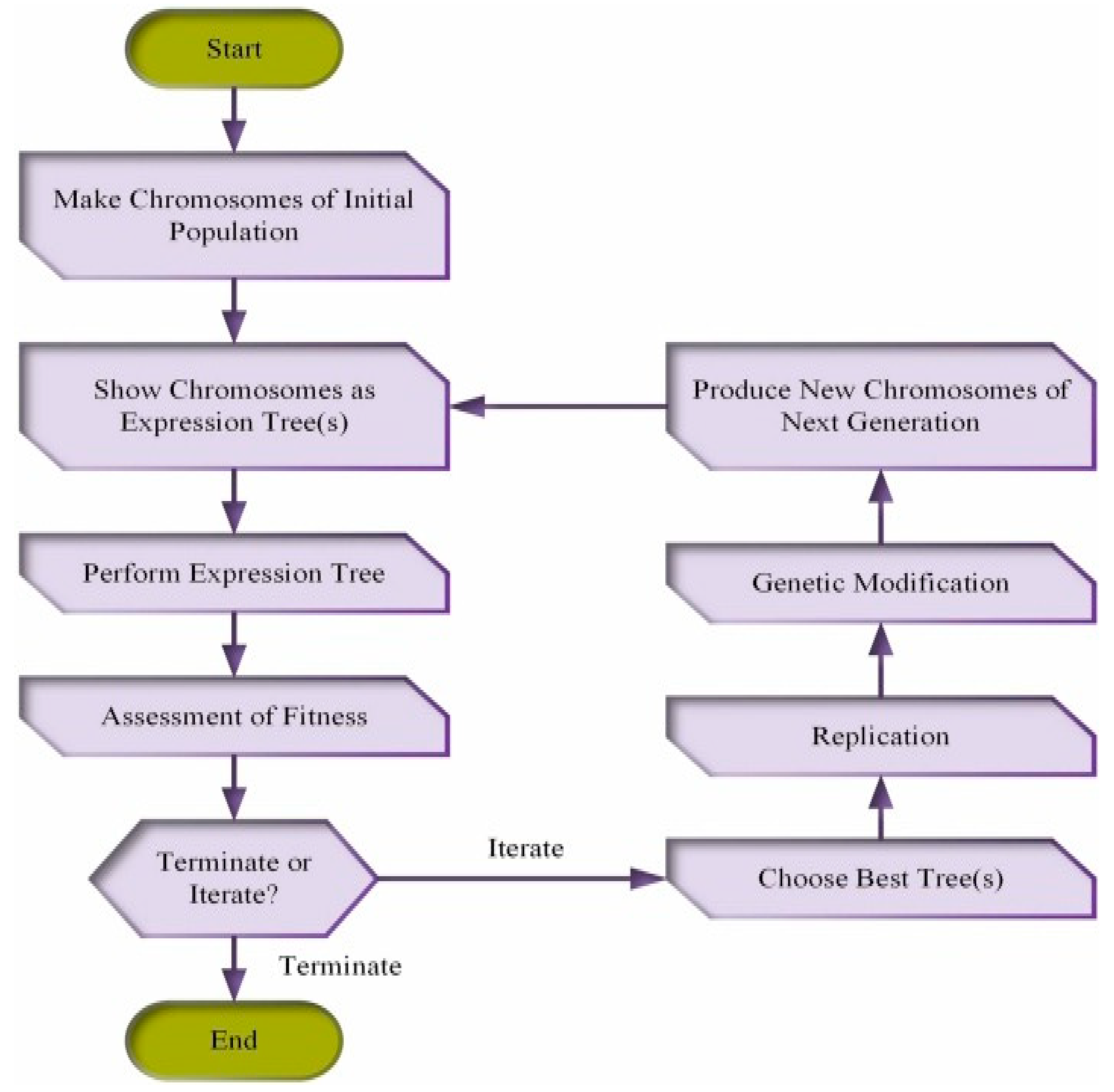


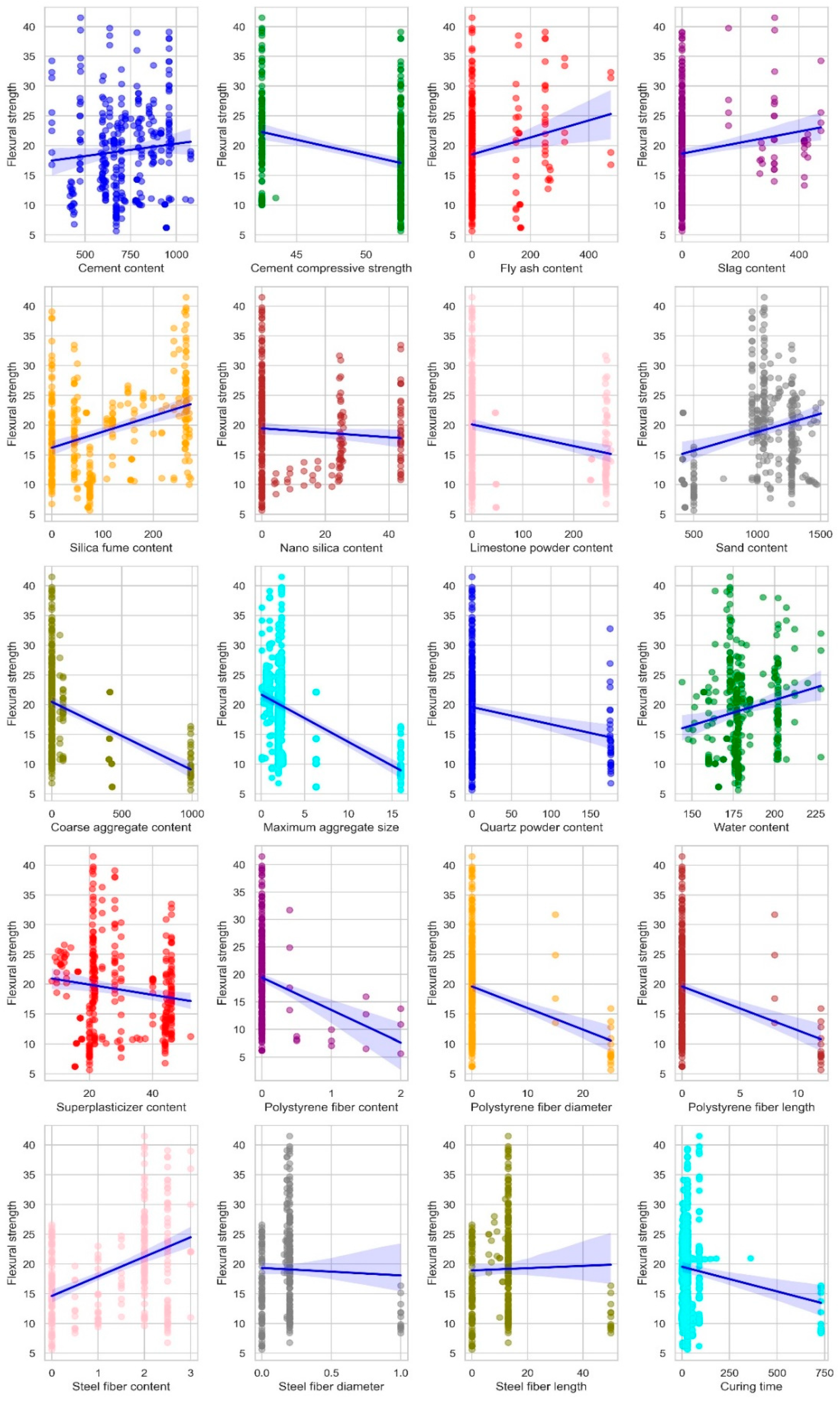
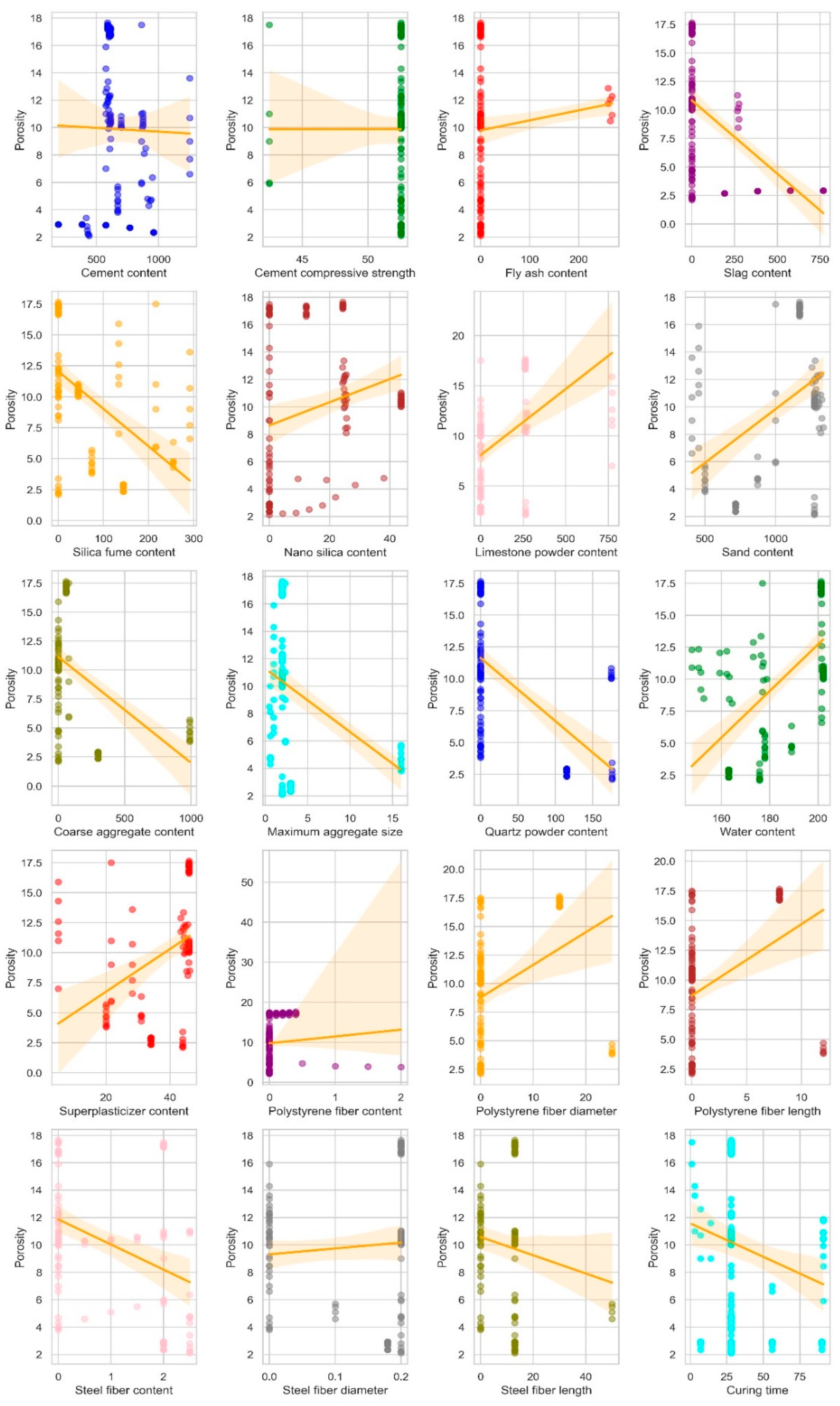
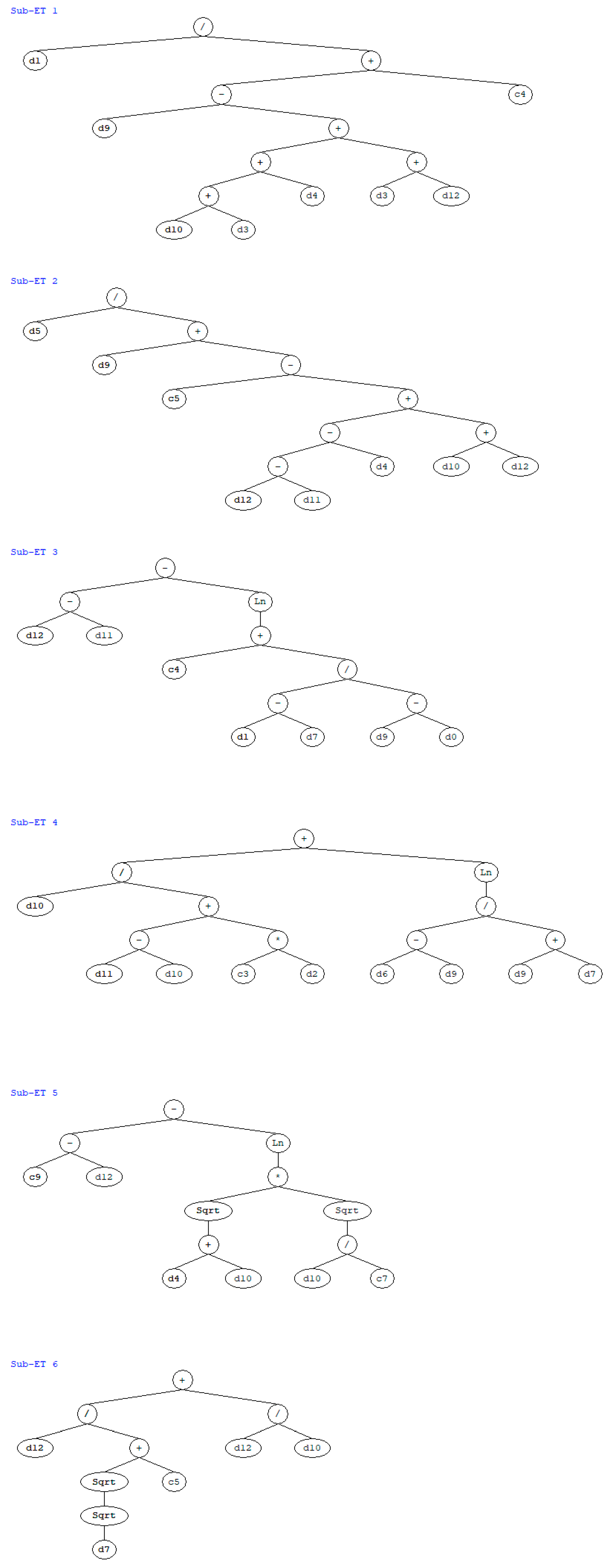

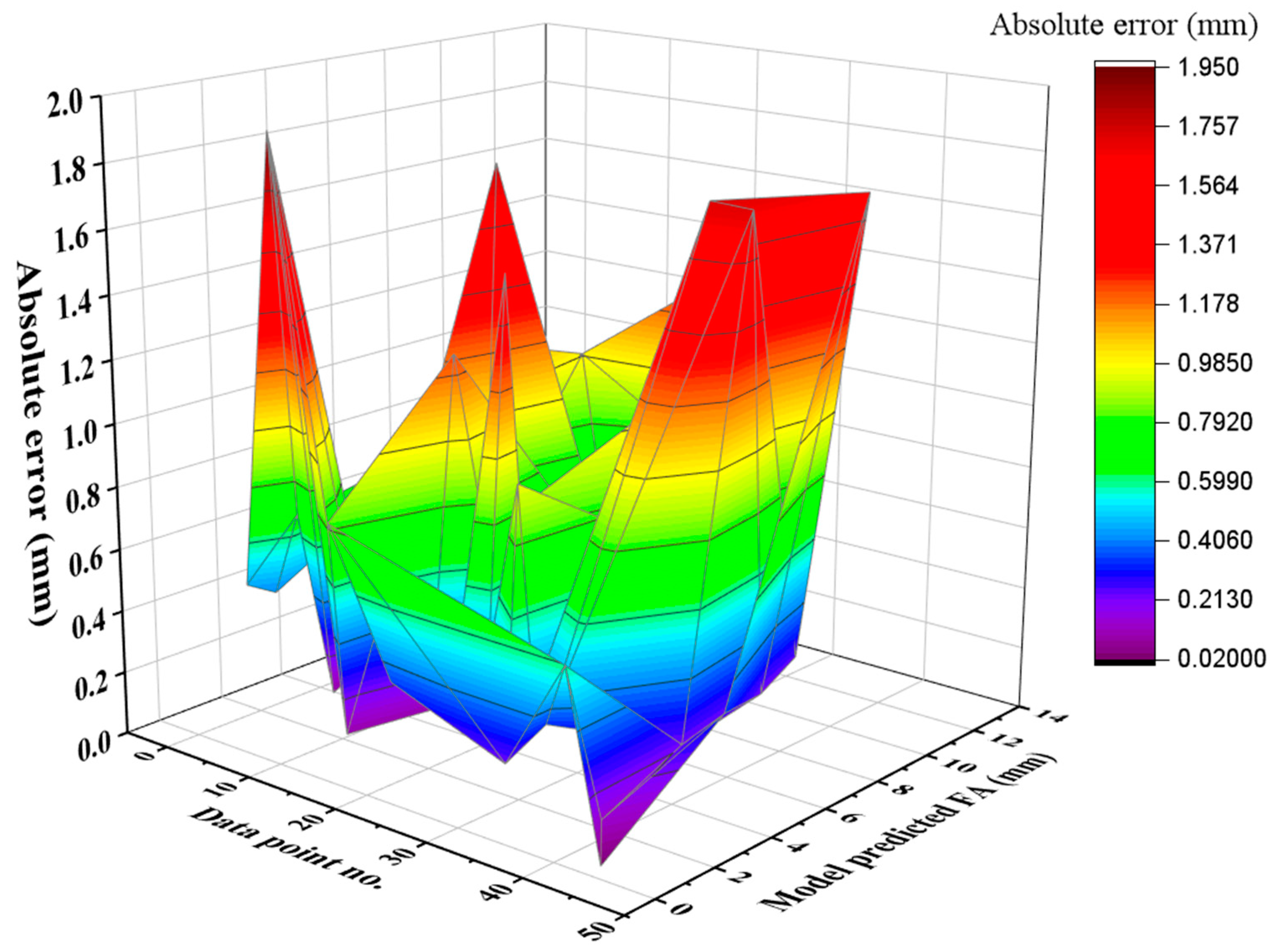
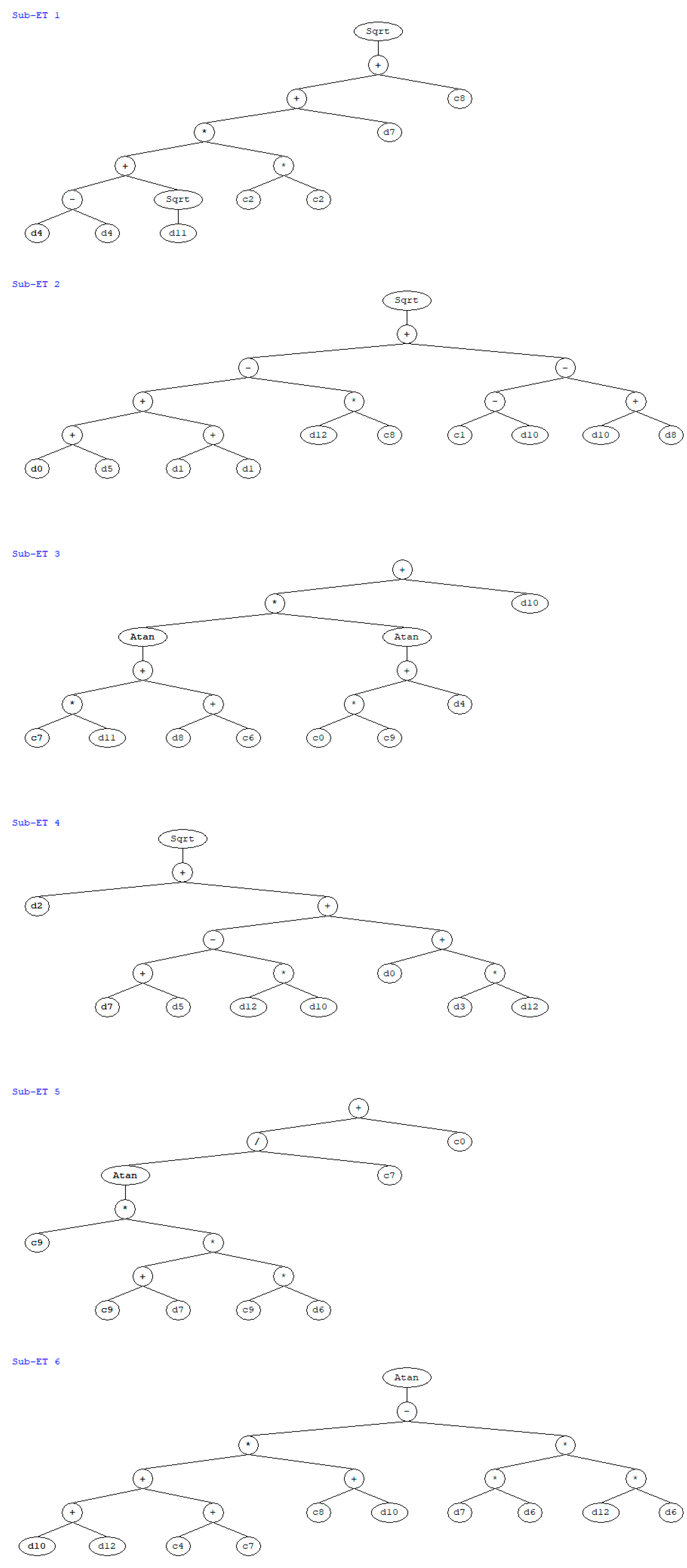

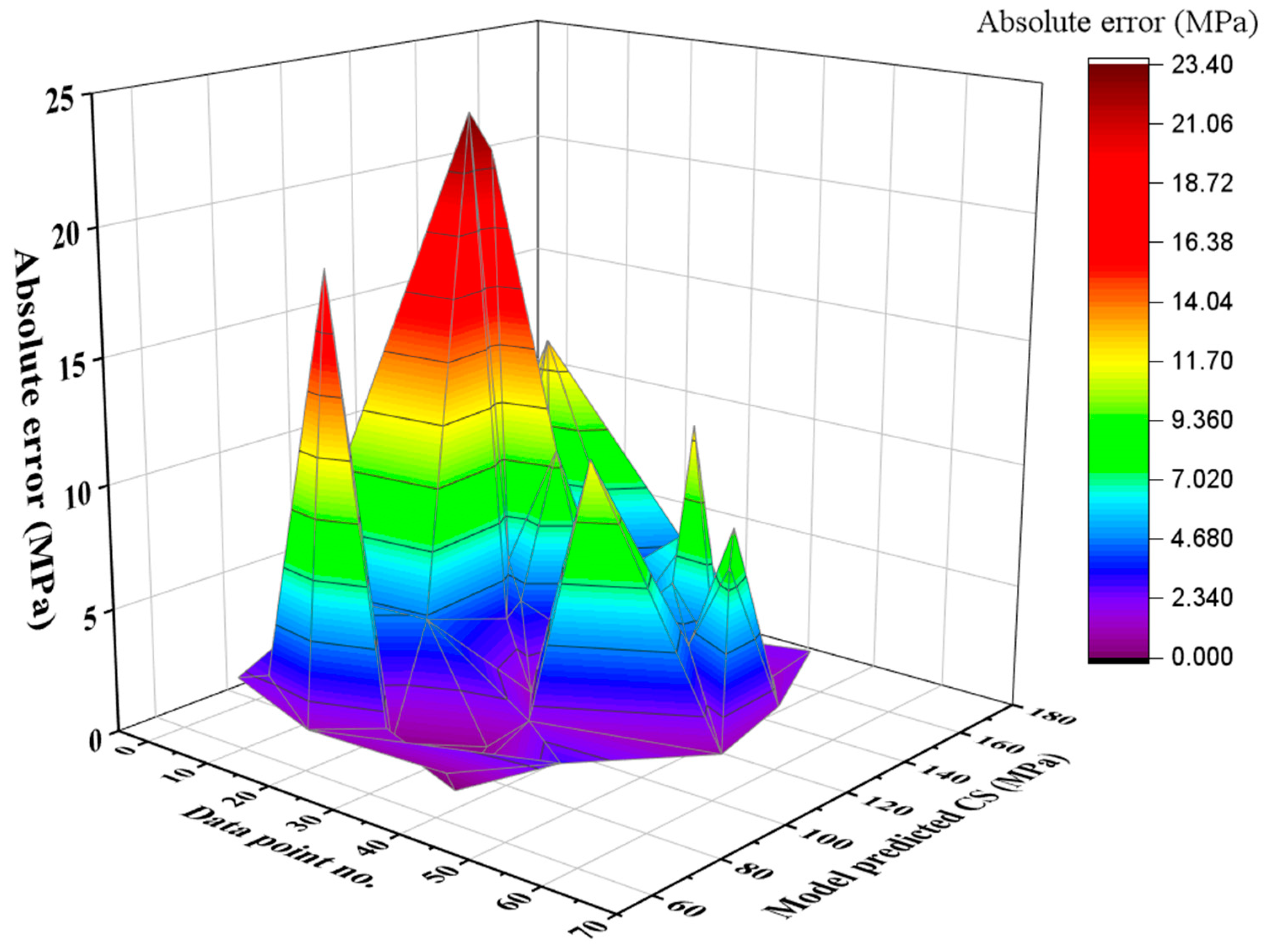

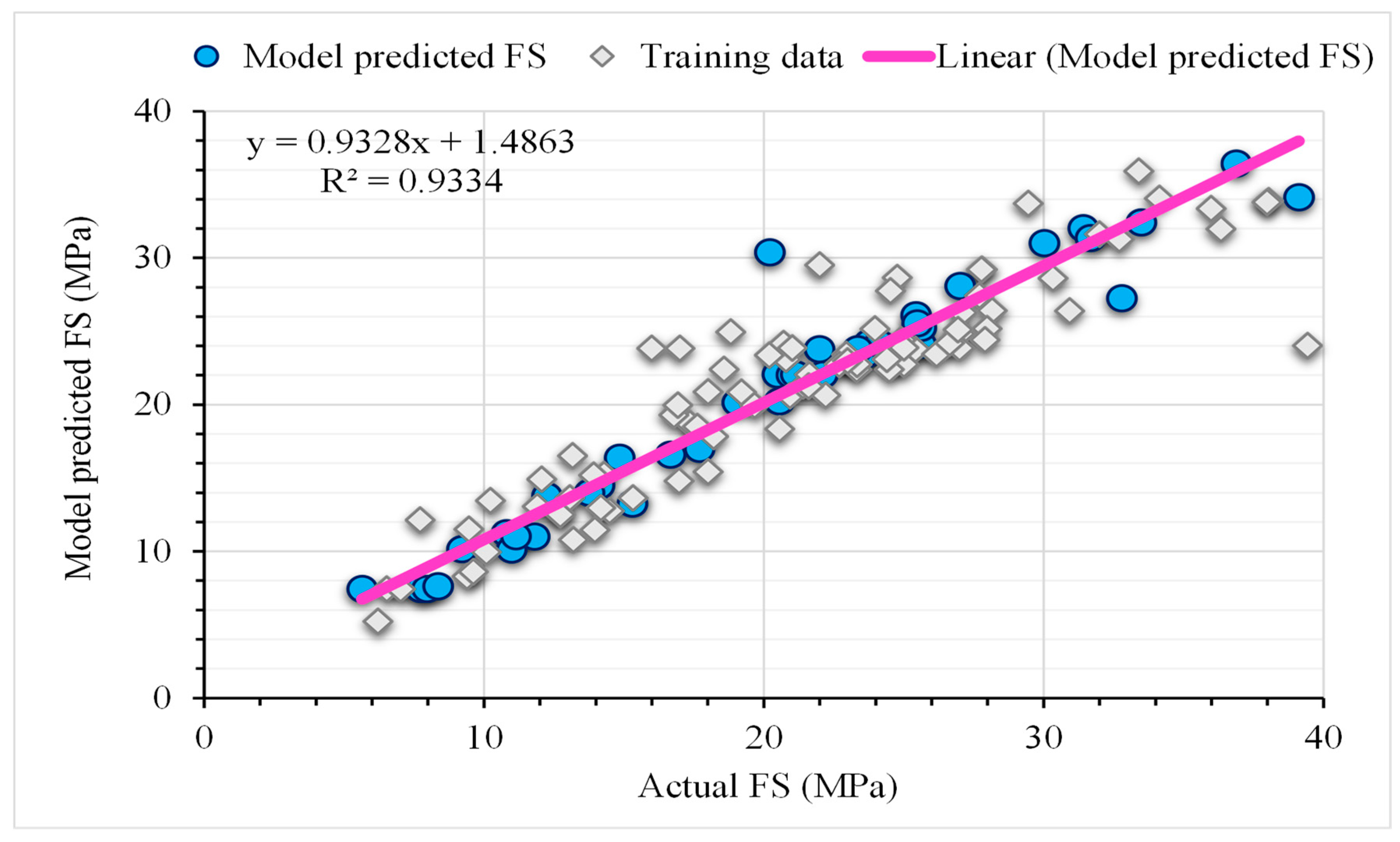


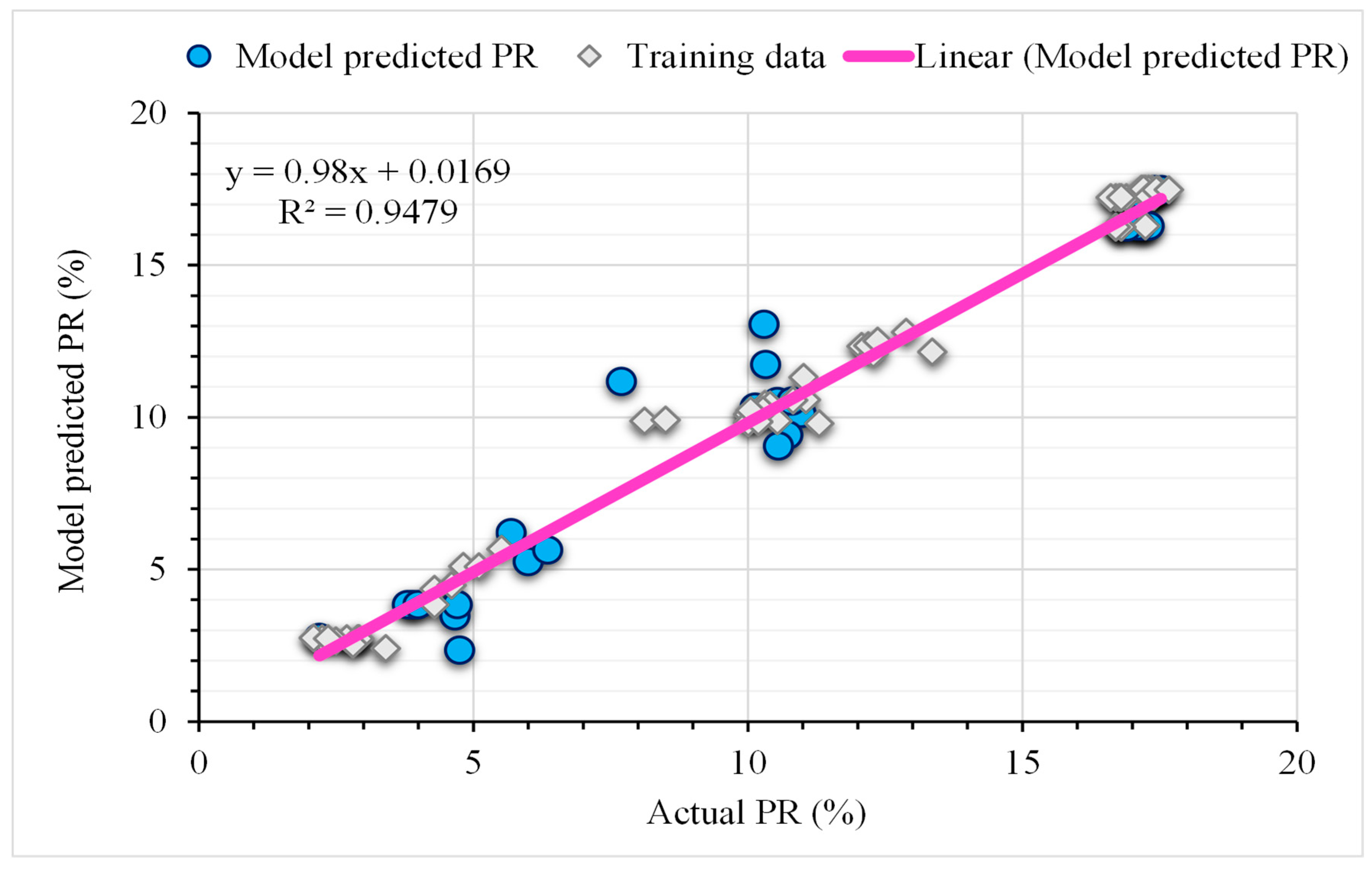

| Parameters | Settings | Parameters | Settings |
|---|---|---|---|
| General | CS | Inversion rate | 0.00546 |
| Genes | 4 | Stumbling Mutation | 0.00141 |
| Constant per gene | 10 | Two-point recombination rate | 0.00277 |
| Chromosomes | 150 | Leaf Mutation | 0.00546 |
| Function set | +, −, x, ÷, cubic root | One-point recombination rate | 0.00277 |
| Head size | 8 | IS transposition rate | 0.00546 |
| Data Type | Floating number | Gene recombination rate | 0.00277 |
| Linking function | Addition | RIS transposition rate | 0.00546 |
| Lower bound | −10 | Gene transposition rate | 0.00277 |
| Upper bound | 10 | Random Chromosomes | 0.0026 |
| Property | Material | Models | R2 | References |
|---|---|---|---|---|
| CS reduction | Recycled glass and eggshell cement composite | ANN | 0.87 | [78] |
| CS | Geopolymer concrete | SVM | 0.78 | [79] |
| CS | Rise husk ash-based concrete | GEP | 0.83 | [65] |
| CS | Alkali-activated materials | KNN | 0.79 | [80] |
| CS | Metakaolin-based concrete | GEP | 0.91 | [81] |
| CS | Fly ash-based geopolymer | DT | 0.90 | [82] |
| CS | Rise husk ash-based concrete | MEP | 0.89 | [65] |
| CS | Geopolymer concrete | MLPNN | 0.81 | [79] |
| FA | UHPC | GEP | 0.94 | This study |
| CS | UHPC | GEP | 0.95 | This study |
| FS | UHPC | GEP | 0.93 | This study |
| PR | UHPC | GEP | 0.94 | This study |
Disclaimer/Publisher’s Note: The statements, opinions and data contained in all publications are solely those of the individual author(s) and contributor(s) and not of MDPI and/or the editor(s). MDPI and/or the editor(s) disclaim responsibility for any injury to people or property resulting from any ideas, methods, instructions or products referred to in the content. |
© 2024 by the authors. Licensee MDPI, Basel, Switzerland. This article is an open access article distributed under the terms and conditions of the Creative Commons Attribution (CC BY) license (https://creativecommons.org/licenses/by/4.0/).
Share and Cite
Qian, Y.; Yang, J.; Yang, W.; Alateah, A.H.; Alsubeai, A.; Alfares, A.M.; Sufian, M. Prediction of Ultra-High-Performance Concrete (UHPC) Properties Using Gene Expression Programming (GEP). Buildings 2024, 14, 2675. https://doi.org/10.3390/buildings14092675
Qian Y, Yang J, Yang W, Alateah AH, Alsubeai A, Alfares AM, Sufian M. Prediction of Ultra-High-Performance Concrete (UHPC) Properties Using Gene Expression Programming (GEP). Buildings. 2024; 14(9):2675. https://doi.org/10.3390/buildings14092675
Chicago/Turabian StyleQian, Yunfeng, Jianyu Yang, Weijun Yang, Ali H. Alateah, Ali Alsubeai, Abdulgafor M. Alfares, and Muhammad Sufian. 2024. "Prediction of Ultra-High-Performance Concrete (UHPC) Properties Using Gene Expression Programming (GEP)" Buildings 14, no. 9: 2675. https://doi.org/10.3390/buildings14092675






